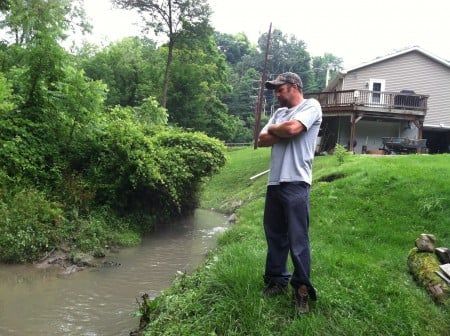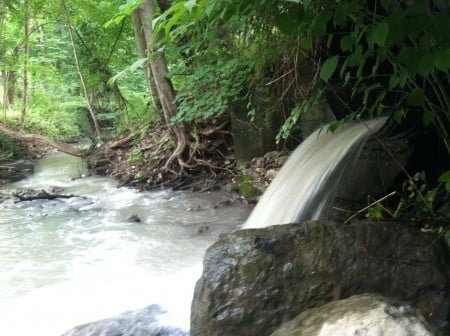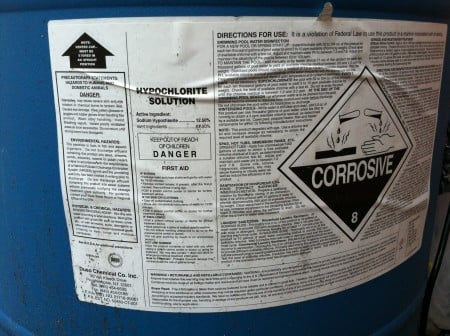Watchdog Identifies Raging Sewer Spill in Kingston

Rob Farris viws the Twaalfskill from his yard, July 9, 2013. (Photo by Dan Shapley)
View more images on our Flickr site
When Rob Ferris moved with his family to Kingston five years ago, one of the draws was the little tributary of the tidal Rondout Creek, the Twaalfskill, where he envisioned his children catching frogs and watching wildlife.
But for five years, he has reported repeated sewage spills into that creek that have fouled the Twaalsfkill and the Rondout, the tidal Hudson’s largest tributary.
After returning home from a recent vacation to the familiar stench of sewage, he not only called the city–again, but also Riverkeeper. We received his report Monday, July 8, and responded that evening by investigating the source of the sewage spill–a pipe discharging sewage less than a half mile upstream of his home. The stream trickles through a culvert under Wilbur Avenue, before being joined by a torrent of sewage from the pipe; the stream from that point until it reaches the Rondout Creek is primarily sewage discharge.
Through his complaints to the city, Mr. Ferris learned that Kingston was treating the sewage effluent with chlorine by injecting it into the pipe before the discharge point in the stream, in an attempt to kill pathogens associated with raw sewage. As many as 3.5 million U.S. residents are sickened by water-borne pathogens from sewage each year, according to the Environmental Protection Agency. More than a dozen homes border the Twaalfskill, and the Rondout Creek is used by boaters, anglers, and at least one kayak club and one kayak business.
Riverkeeper sampled the pipe effluent, as well as the stream water up and downstream, on Tuesday, July 9. The samples we took from the pipe and just downstream had fecal-indicating bacteria counts more than 1,000 times the safe swimming and primary contact levels in spite of the chlorine being added by the City. Chlorination appears to be a poor solution; it isn’t protecting the public from unsafe levels of bacteria, and it poses a severe risk to wildlife in the stream. At the time of Riverkeeper’s observations on July 8 and 9, there were eel and frogs living downstream of the pipe discharge. We mustn’t kill the life in our waterways whenever we have a sewage spill.
City officials were quoted in the Daily Freeman saying that there is no public health threat, but at the same time warning residents to avoid the Twaalfskill
. The city is ignoring an obvious health threat and misinforming the public. Why not be honest?The Sewage Pollution Right to Know Law, which went into effect in May 2013, requires public notification of sewage discharges that may endanger public health, within four hours of the discharge. While the Department of Environmental Conservation has yet to finalize rules defining preferred methods for distributing notifications, the Kingston Wastewater Treatment Plant should have promptly notified community members to the potential health risks via the media and/or by posting signs along the Twaalfskill Brook and the shoreline of Rondout Creek near the confluence of the brook. Mayor Gallo, other city officials, the Ulster County Department of Health and NYS Department of Environmental Conservation all knew about this active sewage overflow since July 8. The public also has the right to know.
Raw sewage is always a public health threat. In this case, Riverkeeper’s water sample results prove it beyond a shadow of a doubt.
The city needs to be honest about public health risks associated with sewage, promptly fix the leaking pipe–and think twice before applying a chemical band-aid by chlorinating a living stream.
Riverkeeper will continue to play our role as watchdog to ensure that this and future spills throughout the Hudson Valley are treated appropriately.


